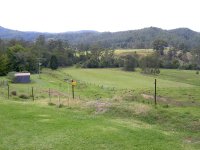Catch95 said:
Its made from roadbase which once a year or so after very heavy rain ends up at the bottom of the slope.
I put in two cross drains - one at the top and one half way down, but these clog in heavy rain.
I'm thinking of using my blade to cut out a drain on the side of the road and then laying geotextile fabric to make it smooth, and then concreting this - similar to what they do on rural roads around here.
I was then going to put some large rocks in the channel to slow down the velocity of the water flow.
Has anyone had experience using concrete on geotextile fabrics?
Mark,
There are some basic steps that go into making a road that will last year round. The most common reason for failure is taking shorts cuts along the way. Each time this happens, it just makes it worse.
From what you've described, it sounds like you have the right idea, but cut a few corners.
Water is your biggest enemy. It's extremly destructive and it never quits. The most important thing you have to deal with is getting it off and away from your road surface. The way you do this is real simple, but oftern very time consuming. The road must be higher then the water when it's flowing. Having a crown to it is important to shed water as quickly as possible. I can't tell 8if you have a crown or not from the picture.
Next, but even more important, you have to have a ditch or channel to keep that water away from your road and get rid of the water. With your steep hill, this should be fairly easy. If you are developing deep canyons in your drainage ditches, then the water is moving too fast and causing erosion. If you have erosion problems, then the rock is a very good solution. In order for this to be effective, you must have enough rock in your ditch to not wash away or allow water to get under or around the rock. It will take allot of rock to be effective. The wider the ditch, the slower the water will move.
You said that your "cross drains" are plugging up on heavy rains. I'm assuming that these are culvert pipes that go under your drive to carry water to the other side of the road? Since they are plugging up, you know that they are too small. Adding more won't fix it, you have to replace them with bigger ones. How big are the ones you have in there? Most drives are done with 12 inch culverts, which are fine. A 15 inch culvert might sound just a bit larger, but it's actualy a huge difference. An 18 inch culvert is massive and can handle almost any amount of rain that you'd ever have. None of those standard sizes should have clogging issues, so I'm wondering if you have yours either too level? or too small?
I'm not sure what you hope to accomplish with the geo textile fabric. It's used mostly for soft soil conditions to help spread the load of the road over a larger area, and to help keep water off of the soil under the gravel. Is your road base soft or unstable?
Since you've been using it for years, it's unlikely that you need fabric. On a steep drive, it might even make things worse.
When gravel is 4 inches thick or more, it locks together. You have to use gravel that has been crushed with sharp edges. The gravel must be of different sizes. You can have some larger stones, but on average, the largest ones should be about the size you can hold in the palm of your hand and get your fingers around. Larger stones will tend to work their way to the surface and not stay in place. The rest of the rock has to be smaller in size all the way down to the size of sand. It's all mixed together evenly and spread out. When driven over and compacted, it interlocks to form a solid, waterproof surface. In fact, when compacted, you won't be able to break it apart without tools like a pick. Heavy rains will run off of the surface and the rock will stay in place.
Over the years, you will lose small amounts of the fines and surface rocks will come loose, but it's a very slow process that is normal in all gravel roads. I figure about every five years or so, you have to add more rock to keep that four inch minumum. Once you get under four inches, the rock will loose it's strength and potholes will develop. Then the rock will start to come apart and the process will just increase until it's washed away.
My guess is that you don't have enough rock if it washes away from heavy rains. Either that, or it's not the right type of rock. I've had contractors try to sell me river rock for road base. When that happend, I fired them on the spot and ended up doing it myself with the proper rock.
I don't understand what you want to use the concrete for? Was that for your drains or for you road surface? Both options are expensive, and if you don't have a proper crown, proper drainage and the right sized culverts, you will be wasting your money on concrete. As with all building, it's all about the basics and a solid foundation.
Good luck,
Eddie

